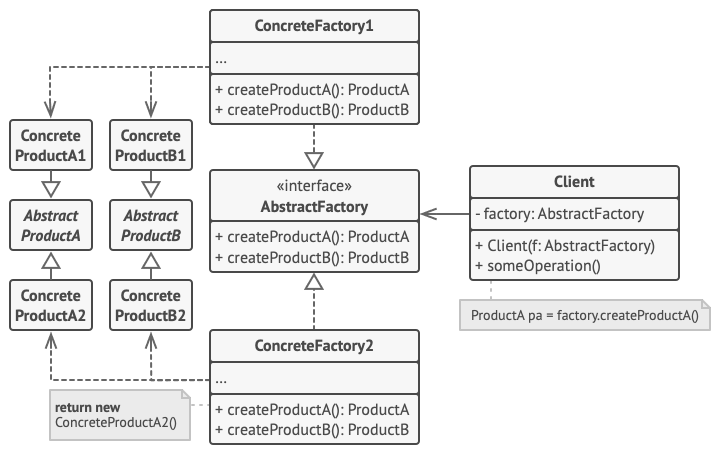设计模式解密:抽象工厂模式的终极指南(PHP/Go双实现)
一、什么是抽象工厂模式?
抽象工厂模式(Abstract Factory Pattern) 是一种创建型设计模式,它提供了一种创建一系列相关或依赖对象的接口,而无需指定具体的类。抽象工厂模式的核心思想是将对象的创建逻辑与使用逻辑分离,同时支持多个产品族的扩展。
核心特征:
产品族:一组相关或依赖的产品。
抽象工厂接口:定义创建产品族中每个产品的方法。
具体工厂:实现抽象工厂接口,创建具体的产品。

二、适用场景
✅ 需要创建一组相关或依赖的对象
✅ 需要支持多个产品族的扩展
✅ 需要解耦客户端代码与具体类
✅ 需要确保产品之间的兼容性
三、抽象工厂模式的组成
1. 抽象产品接口
定义产品的通用接口。
2. 具体产品
实现抽象产品接口的具体类。
3. 抽象工厂接口
定义创建产品族中每个产品的方法。
4. 具体工厂
实现抽象工厂接口,创建具体的产品。
四、PHP实现方案
1. 抽象产品接口
interface Button {
public function render(): string;
}
interface Checkbox {
public function render(): string;
}2. 具体产品
class WindowsButton implements Button {
public function render(): string {
return "Render a button in Windows style";
}
}
class WindowsCheckbox implements Checkbox {
public function render(): string {
return "Render a checkbox in Windows style";
}
}
class MacButton implements Button {
public function render(): string {
return "Render a button in Mac style";
}
}
class MacCheckbox implements Checkbox {
public function render(): string {
return "Render a checkbox in Mac style";
}
}3. 抽象工厂接口
interface GUIFactory {
public function createButton(): Button;
public function createCheckbox(): Checkbox;
}4. 具体工厂
class WindowsFactory implements GUIFactory {
public function createButton(): Button {
return new WindowsButton();
}
public function createCheckbox(): Checkbox {
return new WindowsCheckbox();
}
}
class MacFactory implements GUIFactory {
public function createButton(): Button {
return new MacButton();
}
public function createCheckbox(): Checkbox {
return new MacCheckbox();
}
}5. 使用示例
function renderUI(GUIFactory $factory) {
$button = $factory->createButton();
$checkbox = $factory->createCheckbox();
echo $button->render() . "\n";
echo $checkbox->render() . "\n";
}
// 使用示例
$factory = new MacFactory();
renderUI($factory);
// 输出:
// Render a button in Mac style
// Render a checkbox in Mac style五、Go实现方案
1. 抽象产品接口
package main
import "fmt"
type Button interface {
Render() string
}
type Checkbox interface {
Render() string
}2. 具体产品
type WindowsButton struct{}
func (b WindowsButton) Render() string {
return "Render a button in Windows style"
}
type WindowsCheckbox struct{}
func (c WindowsCheckbox) Render() string {
return "Render a checkbox in Windows style"
}
type MacButton struct{}
func (b MacButton) Render() string {
return "Render a button in Mac style"
}
type MacCheckbox struct{}
func (c MacCheckbox) Render() string {
return "Render a checkbox in Mac style"
}3. 抽象工厂接口
type GUIFactory interface {
CreateButton() Button
CreateCheckbox() Checkbox
}4. 具体工厂
type WindowsFactory struct{}
func (f WindowsFactory) CreateButton() Button {
return WindowsButton{}
}
func (f WindowsFactory) CreateCheckbox() Checkbox {
return WindowsCheckbox{}
}
type MacFactory struct{}
func (f MacFactory) CreateButton() Button {
return MacButton{}
}
func (f MacFactory) CreateCheckbox() Checkbox {
return MacCheckbox{}
}5. 使用示例
func renderUI(factory GUIFactory) {
button := factory.CreateButton()
checkbox := factory.CreateCheckbox()
fmt.Println(button.Render())
fmt.Println(checkbox.Render())
}
func main() {
factory := MacFactory{}
renderUI(factory)
// 输出:
// Render a button in Mac style
// Render a checkbox in Mac style
}六、关键实现差异对比
七、模式优缺点分析
👍 优点:
解耦创建逻辑:将对象的创建与使用分离。
支持扩展:新增产品族时,无需修改客户端代码。
确保兼容性:同一工厂创建的产品是兼容的。
👎 缺点:
增加复杂度:引入额外的类和接口。
过度设计:简单场景下可能显得冗余。
八、实际应用案例
1. 跨平台UI组件
根据操作系统创建不同风格的UI组件。
2. 数据库访问层
根据数据库类型创建连接、命令等对象。
3. 游戏角色装备
根据角色职业创建武器、防具等装备。
九、总结
抽象工厂模式是解决复杂对象创建问题的经典设计模式。通过将对象的创建逻辑封装在工厂类中,我们可以实现代码的解耦、扩展和维护。无论是PHP还是Go,抽象工厂模式都能显著提升代码的灵活性和可读性。
在下一篇文章中,我们将深入探讨 建造者模式 及其在复杂对象构建中的应用。敬请期待!
下一篇预告:设计模式系列(四)——建造者模式:构建复杂对象的艺术
License:
CC BY 4.0